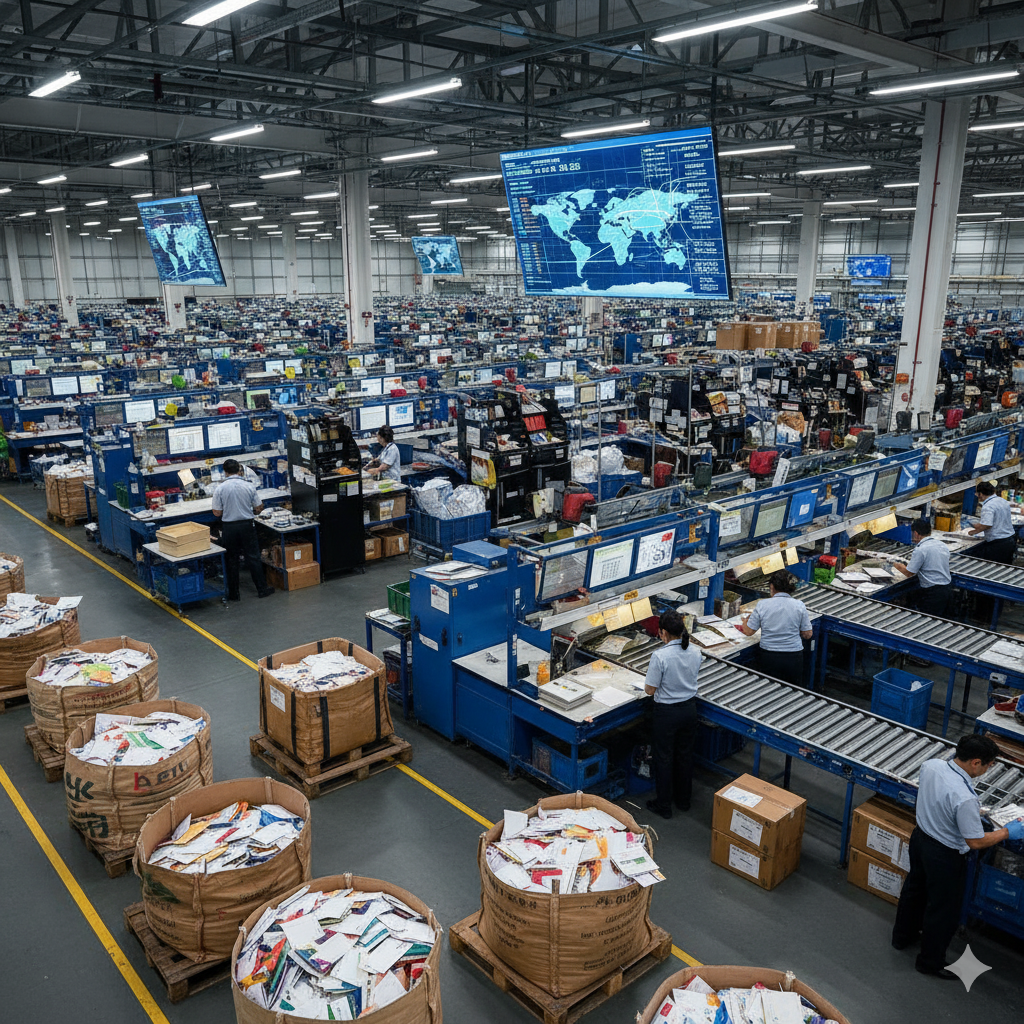If you’re like most eCommerce shippers today, you’re being squeezed from all sides. Your customers expect Amazon-like delivery times, your competition is global, and the regulatory landscape seems to shift under your feet almost daily, forcing you to constantly rethink your shipping strategies as fees and compliance costs keep rising.
You’re not alone. There are thousands of small businesses just like yours experiencing the same problems, looking for that competitive edge that will enable them to protect profit margins and thrive, not merely survive.
Recent data from ePost’s Shipping Optimization Analysis reveals patterns that could change your approach to international shipping. The insights focus on product category distribution, customs complexity and value patterns – critical factors that directly impact your bottom line through more efficient shipping, smoother customs management and smarter tariff strategies that align with customer expectations and reduce cart abandonment.
There are new rules to the game. But as you’ll discover, this changed environment presents as many opportunities as challenges to companies that are agile enough to adjust their strategy.

Understanding the New Rules of Global Shipping
Global shipping rules can be likened to the rule book of a complex game – except that the rule book varies depending on the country you are shipping to and the goods that you are shipping through eCommerce platforms and online stores.
Every day, your shipments must navigate a gauntlet of customs authorities asserting their country’s regulations through duties, taxes and compliance requirements. According to ePost’s research, businesses that master these systems—especially those using third-party logistics or flexible shipping solutions— can minimize costs and delays – a true competitive advantage you can take to the bank.
Your Strategic Edge: De Minimis Thresholds
One of your most powerful tools as an eCommerce business is awareness of and leveraging “de minimis value” thresholds – the monetary value below which your imported goods are not subject to customs duties and taxes.
These thresholds vary dramatically across the world:
- United States: $800 (a tremendous opportunity for your U.S.-bound shipments excluding China and Hong Kong)
- European Union: 150 euros (encompassing many mid-value items)
- Many other countries: As low as $20 (requiring strategic planning)
Here’s why this is so interesting: ePost data shows that 97% of product categories fall below the EU de minimis threshold. That means for your shipping process, there’s an immediate opportunity to set up shipments in configurations that can significantly reduce customs costs and help streamline international operations.
Don’t Let Product Classification Trip You Up
Product categorization with Harmonized System (HS) codes directly affects how your shipments are processed at customs, including what duties and taxes are imposed. Get it incorrect, and you’re looking at delays, extra costs and unhappy customers due to order fulfillment and shipping policy mistakes.
Inaccurate HS coding is one of the most common causes of customs delays – especially when eCommerce platforms automatically assign codes that may not actually fit your products, state ePost’s experts.
As Alison Layfield, director of product development at ePost Global, warns:
“Defaulting on HS codes is no longer safe – your product could end up on a 25% tariff. Customs is now requiring accurate classifications, which equates to clear descriptions, correct HS codes, declared value and actual country of origin based on the manufacturer.”
This is beyond bureaucratic formality – it has a direct impact on your cost of shipping, shipping budget, and transit time. “Close enough” classification is a relic of the past, and precision is now a competitive necessity.
What Your Product Mix Says About Your Shipping Strategy
Let’s get practical. The ePost analysis provides up-to-date shipping trends to help you benchmark your operation and identify areas for revision.
Where Your Value Is Concentrated
The distribution of shipping value by product categories shows where most shippers are concentrating their efforts:
- Clothing and Textiles: 39.2% of total value ($179.3 million)
- Luxury and Personal Goods: 16.8% of total value ($70.1 million)
- Books and Printed Matter: 12.5% of total value ($27.6 million)
- Electronics and Technology: 10% of total value ($51.4 million)
How does your product mix compare? If you are shipping in these high-value categories, you will have to take special care of their individual customs requirements, tariff ramifications, and carrier rates—since shipping costs can vary significantly based on product type, destination, and service level.. If your mix is different, you might have unique opportunities your competitors don’t know about.
Not All Products Are Created Equal
One of the most insightful findings in the ePost report is how much customs complexity varies by product category. Understanding where your products fall on this spectrum can allow you to plan for headaches, shipping fees, and resource allocation accordingly, especially for an eCommerce business navigating international fulfillment.
Low Complexity (Smooth Sailing):
- Books and Printed Materials
- Industrial Materials
- Miscellaneous products
These products tend to have streamlined entry processes unless targeted for specific risks – allowing more predictable timetables and costs.
Medium Complexity (Plan Accordingly):
- Apparel and Textiles
- Furniture and Home
- Transportation goods
These must be properly classified, valued and meet agency-specific requirements – where a little preparation with your shipping software or third-party logistics partner can go a long way..
High Complexity (Tread with Caution):
- Electronics and Technology
- Food and Beverages
- Luxury and Personal Goods
These high-complexity product groups have multiple government agencies implicated, intricate rulings and high exposures to penalties for non-compliance. If these are in your product line, expert guidance is essential.
Here’s a reality check: 42% of shipping value falls into high or very high customs complexity categories. If you’re shipping in these categories, you’re in the big leagues of customs complexity, and your strategy needs to be accordingly. Ensuring efficient shipping and minimizing delays is essential for protecting profit margins and maintaining a consistent customer experience.

Practical Strategies You Can Implement Today
The ePost data reveals clear patterns that translate into practical strategies you can use to streamline your shipping process and improve both efficiency and cost control.
Smart Approaches to Small-Value Shipments
If your business ships products in the 117 product categories with average prices under $20 (representing 18.9% of total value), there is a great chance that you can realize cost savings through consolidation.
Instead of shipping these low-value products separately, consider batch processing non-urgent shipments. This can reduce your per-item shipping cost by a substantial amount without impacting customer satisfaction – especially for repeat customers who understand the value tradeoff.
Playing the Threshold Game
That your product value ranges match international customs thresholds creates strategic possibilities that you cannot ignore:
- 52% of categories (19% of value) fall below the $20 threshold of most nations
- 45% of categories (64% of value) fall in the $20-$100 range
- Only 3% of categories (17% of value) exceed $100 but remain below the U.S. $800 de minimis threshold
What does this imply for you? Based on the markets that you sell to and your shipping needs, you might achieve an edge by scheduling shipments to reap de minimis benefits – perhaps splitting high-value orders into multiple shipments where it is suitable, or merging products to reach ideal values for intended markets.
Match Your Shipping Method to Your Product Value
The ePost information shows huge differences in value-to-weight ratios among categories – a logistics expert’s term for “value density.” This insight can transform how you select shipping options and choose between shipping carriers.
For high density value items like electronics and luxury goods, premium carriers and rush delivery typically pencil out financially based on the value of your goods. For low density value items like books and apparel, cheaper ground shipping methods tend to offer the best return on your shipping dollar, especially when paired with automated shipping software to manage routing and labeling.
By matching your shipping method to your product’s value density, you can optimize both cost and customer satisfaction at the same time.
Bewildering Tariffs
Here’s a statistic that should grab your attention: Roughly 72.8% of categories that ePost analyzed (representing 79.5% of total value) fall into tariff-sensitive classifications. These are products that are facing high customs duties or special trade measures.
The Big Five to Watch
The five most tariff-sensitive categories by value are:
- Apparel and Textiles: $179.3 million
- Luxury and Personal Items: $70.1 million
- Electronics and Technology: $51.4 million
- Industrial Materials: $25.3 million
- Transportation: $8.5 million
If your business sells in those categories, your tariff strategy isn’t just a cost matter – it’s a fundamental competitive matter that can break or make your international growth and influence your entire ecommerce shipping approach.
Where You Manufacture Is More Important Than Ever
The report from ePost includes some shocking observations about manufacturing location decisions:
- Products manufactured in the U.S. are hit with a 25% surcharge when sold in certain markets abroad
- Apparel produced in China typically face an 18% duty rate – lower than the U.S. surcharge
These differentials create strategic sourcing implications that go beyond labor, packing materials, and production costs.
The bottom line? Your sourcing decision needs to consider the total landed cost—including tariffs, duties, taxes, and broader supply chain impacts—not just where it’s cheapest to manufacture. Sourcing decisions also affect delivery options and final product prices, both of which play a major role in shaping customer expectations.
Documentation: Your First Line of Defense
In shipping today, proper documentation isn’t paperwork – it’s insurance for your business and your customers. From accurate shipping labels to compliant data tied to your shipping service, the report from ePost identifies four areas of documentation you can’t afford to get wrong:
- Accurate product descriptions: Descriptions that are too vague or incorrect can trigger customs inspections and hold up your shipments for days or weeks
- Correct HS codes: Default marketplace codes won’t always suffice – invest in proper classifications
- Precise retail value statements (alongside declared package weight and dimensional weight): Understatement can lead to penalties, while overstatement unnecessarily inflates duty costs — and both can affect the total product prices that appear in your shopping cart
- Correct country of origin statements: This directly affects applicable tariff rates and trade agreement benefits
If you’re exporting product categories of high complexity, consider implementing a risk-based documentation strategy that aligns with your broader shipping policy and automates high-risk shipment reviews.. Pre-clearance programs for your routine high-complexity shipments can also save you significant headaches down the road.
The Road Ahead: What to Watch For
The ePost study identifies several emerging issues that will affect your international shipping operations in the coming months:
Increased Scrutiny at the Border
Customs agencies worldwide are implementing more active enforcement of import rules, with greater documentation stringency, particularly for consolidated shipments. Even minor inconsistencies—like packaging errors or incorrect packing materials—can now result in delays, package returns, and additional costs. This heightened oversight is especially important for ecommerce shipping operations, where volume and speed leave less room for error. Accuracy matters now more than ever, especially when customers expect real-time updates on the status of their order and consistent fulfillment from click to doorstep.
Navigating a Complex Compliance Landscape
Rapidly changing regulations require constant monitoring and adaptation, with various interpretations by various government agencies adding to the complexity. If you’re consolidating goods from a variety of sources, expect your documentation requirements to become more demanding.
Finding the Right Partners
In this complex environment, having experienced logistics partners by your side isn’t a luxury – it’s a requirement. Expertise in areas like documentation, classification and compliance from seasoned logistics partners can prevent costly delays, while responsiveness and agility are now essential characteristics in shipping partners. The right partner can also help strengthen customer loyalty by ensuring reliable delivery options and preventing delays that could impact the customer’s order experience.
Your Action Plan: Five Steps to Shipping Success
Based on the ePost analysis, here are five actionable steps you can take to transcend the complexities of global shipping:
1. Develop a Value-Based Shipping Strategy
Develop a tiered approach to shipping by product value with dedicated strategies for products that fall within various de minimis thresholds. Look at promotional strategies that push order values that are duty and tax optimized – a win-win for you and your customers.
2. Invest in Classification Expertise
If you’re shipping tariff-sensitive product categories, accurate HS classification can yield significant duty savings. Consider partnering with experienced customs brokers to avoid misclassification pitfalls – the ROI can be quite compelling.
3. Implement Risk-Based Documentation
Establish tiered documentation requirements by customs complexity categories, with more extensive procedures for high-complexity shipments. Implement electronic documentation libraries for repeat shipments of the same items to ensure consistency and compliance.
4. Rethink Your Sourcing Decisions
Evaluate manufacturing location decisions in light of their tariff implications, not merely production costs. Monitor changing trade agreements and tariff schedules to identify emerging opportunities or risks that could affect your sourcing strategy.
5. Match Carriers to Product Value
Implement automated routing based on value density metrics, utilizing premium carriers for high-value density items while reserving cost-effective shipping for low-value density products. This balanced approach optimizes both cost and customer satisfaction.
Your Competitive Advantage
The ePost Product Category Analysis imparts a fundamental truth about global shipping today: thriving requires strategy, not just logistics. When 42% of shipping value falls into high-complexity customs categories and nearly 80% of value is tariff-sensitive, you cannot afford an ad hoc global shipping strategy.
The study shows that mid-market shippers who develop sophisticated, data-driven shipping strategies – leveraging de minimis thresholds, simplifying classification, utilizing risk-based documentation and making strategic sourcing decisions – will enjoy significant competitive advantages in the global marketplace.
Since global trade regulations will certainly keep evolving, the fundamentals of good documentation, accurate classification and tactical shipping tactics remain the foundation of profitable cross-border trade. By mastering the fundamentals, you can transform international shipping into a genuine competitive advantage rather than an inevitable expense.




